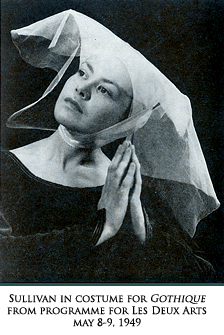 | ||||||||
| ||||||||
 | ||
After the initial negative reaction against Refus Global, the manifesto soon receded in the public's consciousness. For the Automatists, however, the publication had serious and long-term consequences. Most notably, Borduas was fired from his job as a teacher at École du meuble and, once the group lost its centrifugal force, its members slowly spun off into different artistic directions though most would remain in close, personal contact. The following year, 1949, perhaps in part because her parents had disapproved of her signing Refus Global, Sullivan began to collaborate with artists beyond her immediate Automatist circle. She and her student dancers joined forces with Alexander Kerby, Director of Theatre 6, for a production that featured both dance and theatre. While Sullivan only used her own dancers in the dance pieces and Kerby used his actors in the theatre pieces, the event was an attempt to find parallels and compatibility between these two performing arts. Les Deux Arts, as the concert was called, was held May 8 and 9, at Le Théâtre des Compagnons. Eight of Sullivan's dances were included in Les Deux Arts concert. Black and Tan, and Berceuse, a new group piece, set to percussion accompanied by Louis Charboneau, were the first two dances performed. Collaborating with one of her students, Racheed Aboud, Sullivan performed in a dance listed in the Les Deux Arts house programme as Lucrèce. The music for both Lucrèce and the next piece of the evening, Femme Archaïque, was composed by Pierre Mercure. Sullivan borrowed the title of Femme Archaïque from a painting she had purchased by fellow Automatist, Jean-Paul Mousseau. Sullivan began and ended the dance in the same position as the figure in Mousseau's painting: looking out at the audience, feet in parallel first, arms bent at the elbows with her left hand over her pelvic region in the front and her right hand in the same position behind her back. Sullivan's costume was a facsimile of the white garb with dark designs on it that appeared in the artwork. She performed in low lighting except for a spotlight on Mousseau's painting, which hung upstage. The dance, Sullivan explained many years later, was about "women before historical times." In an interview, Sullivan stated that: "When I did Femme Archaïque, I didn't realize what I was doing until after it was done. But now I know there is a mythic quality to it. I still like, am fascinated by, myth, the content of myth in the world." Ecstatic twirling with violent shaking of the dancer's arms and upper torso, as if the dancer were in a trance or a conduit for intense energy, defines Femme Archaïque along with contrasting moments of restricted movement. Its movement dynamics, which teeter between apparent abandon and control, ecstasy and complete restraint, resonate on a primal level. This is a dance about the visceral contrasted with the refined - the so-called primitive co-existing with the contemporary. Another dance presented as part of the Les Deux Arts concert included the solo Gothique. The dance was inspired by statues from Gothic churches and, throughout the piece, Sullivan slipped in and out of poses inspired by sculptures and paintings. This piece was the highlight of the evening, according to Harold Whitehead, a reviewer for The Montréal Gazette who attended the production. In [Gothique] (by far the best) [Sullivan] represents a 15th century woman and mimes the emotions expressed in a haunting love song of the period. The short dance had the charming unreality of a scene from the past coupled with the slow motion of a dream sequence and the result was extremely pleasing to the eye. Au Bazar, a light-hearted piece choreographed and performed by Racheed Aboud, one of Sullivan's students, was also highly praised. Dualité was presented by Sullivan and one of her students, Penny Kondaks. The final dance piece performed that evening was Deux Danses à Midi, another group piece choreographed by Sullivan. Like Berceuse, Deux Danses à Midi was performed to percussion music. The response to Sullivan's choreography for Les Deux Arts was mixed. The Montréal Gazette's Whitehead wrote that the audience's appreciation was tremendous: "Miss Sullivan has a charming stage personality and is an easy, relaxed dancer, and from the amount of hand-clapping and enthusiastic shouts of 'Bravo' which greeted her every appearance on the stage, she has a very large following in the city." Although another writer, Jean Luce, praised Sullivan's acrobatic skills and her promising talent, reviewer Jean Vincent was more ambivalent in his comments. While Sullivan showed imagination and taste, Vincent wrote, such attributes did not add to the vocabulary of "neo-paganism" the young choreographer appeared to be exploring in works like Femme Archaïque. Vincent confessed that he did not understand Sullivan's use of hand gestures in this piece. Her turned out palms and finger movements reminded him of classical Indian choreography, but appeared to him to be out of place in a modern piece. (next page) ©2006, Dance Collection Danse | ||

